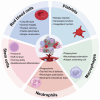Theoretical basis, state and challenges of living cell-based drug delivery systems
- PMID: 39267776
- PMCID: PMC11388066
- DOI: 10.7150/thno.99257
Theoretical basis, state and challenges of living cell-based drug delivery systems
Abstract
The therapeutic efficacy of drugs is determined, to a certain extent, by the efficiency of drug delivery. The low efficiency of drug delivery systems (DDSs) is frequently associated with serious toxic side effects and can even prove fatal in certain cases. With the rapid development of technology, drug delivery has evolved from using traditional frameworks to using nano DDSs (NDDSs), endogenous biomaterials DDSs (EBDDSs), and living cell DDSs (LCDDSs). LCDDSs are receiving widespread attention from researchers at present owing to the unique advantages of living cells in targeted drug delivery, including their excellent biocompatibility properties, low immunogenicity, unique biological properties and functions, and role in the treatment of diseases. However, the theoretical basis and techniques involved in the application of LCDDSs have not been extensively summarized to date. Therefore, this review comprehensively summarizes the properties and applications of living cells, elaborates the various drug loading approaches and controlled drug release, and discusses the results of clinical trials. The review also discusses the current shortcomings and prospects for the future development of LCDDSs, which will serve as highly valuable insights for the development and clinical transformation of LCDDSs in the future.
Keywords: Clinical transformation; Controlled drug release; Drug loading approaches; Living cells; Targeted drug delivery.
© The author(s).
Conflict of interest statement
Competing Interests: The authors have declared that no competing interest exists.
Figures










Similar articles
-
Recent Advances in Metal-Organic Frameworks as Anticancer Drug Delivery Systems: A Review.Anticancer Agents Med Chem. 2021;21(18):2487-2504. doi: 10.2174/1871520621666210119093844. Anticancer Agents Med Chem. 2021. PMID: 33463479 Review.
-
Nanocarrier-Based, ocular drug delivery: Challenges, prospects, and the therapeutic landscape in the United Arab Emirates.Int J Pharm. 2024 Dec 25;667(Pt B):124899. doi: 10.1016/j.ijpharm.2024.124899. Epub 2024 Nov 7. Int J Pharm. 2024. PMID: 39521159 Review.
-
Research Progress in Bioinspired Drug Delivery Systems.Expert Opin Drug Deliv. 2020 Sep;17(9):1269-1288. doi: 10.1080/17425247.2020.1783235. Epub 2020 Jun 25. Expert Opin Drug Deliv. 2020. PMID: 32543953 Review.
-
Versatile Types of Polysaccharide-Based Drug Delivery Systems: From Strategic Design to Cancer Therapy.Int J Mol Sci. 2020 Dec 1;21(23):9159. doi: 10.3390/ijms21239159. Int J Mol Sci. 2020. PMID: 33271967 Free PMC article. Review.
-
Poly(phenylalanine) and poly(3,4-dihydroxy-L-phenylalanine): Promising biomedical materials for building stimuli-responsive nanocarriers.J Control Release. 2024 Aug;372:810-828. doi: 10.1016/j.jconrel.2024.07.002. Epub 2024 Jul 5. J Control Release. 2024. PMID: 38968969 Review.
Cited by
-
Blood-brain barrier-penetrating Angiopep-2/Sirtuin 1 nanoparticles rescue sevoflurane neurotoxicity through multi-omics identified necroptosis pathways.J Nanobiotechnology. 2025 Aug 21;23(1):579. doi: 10.1186/s12951-025-03639-w. J Nanobiotechnology. 2025. PMID: 40841659 Free PMC article.
References
Publication types
MeSH terms
Substances
LinkOut - more resources
Full Text Sources

